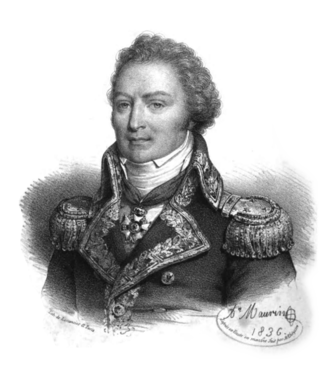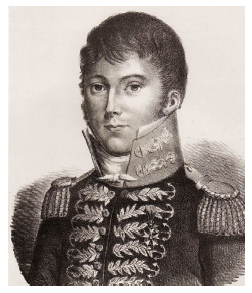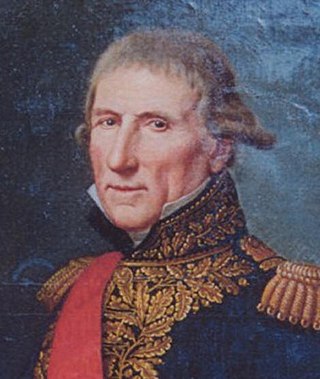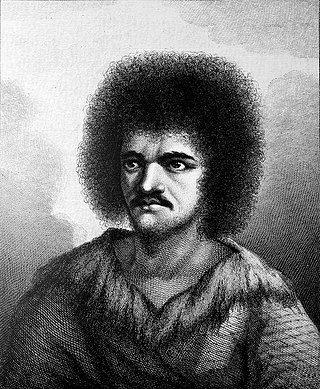
Yves-Joseph de Kerguelen-Trémarec was a French Navy officer. He discovered the Kerguelen Islands during his first expedition to the southern Indian Ocean. Welcomed as a hero after his voyage and first discovery, Kerguelen fell out of favour after his second voyage and was cashiered for violating Navy regulations. He was rehabilitated during the French Revolution.

Louis-René Madelaine Le Vassor, comte de La Touche-Tréville was a French vice-admiral. He fought in the American War of Independence and became a prominent figure of the French Revolutionary Wars and of the Napoleonic wars.

Alexis-Marie de Rochon, known as Abbé Rochon, was born in Brest, France on 21 February 1741, and died in Paris on 5 April 1817. He was a French astronomer, physicist and traveller. He worked on lens design and crystal optics, inventing the Rochon prism polariser.

Vice Admiral Pierre César Charles Guillaume, Marquis de Sercey, born at the Château du Jeu, La Comelle on 26 April 1753 and died in Paris, 1st arrondissement on 10 August 1836, was a French naval officer and politician. He is best known for his service in the American Revolutionary War, his role in Saint-Domingue and the Mascarene Islands, and for commanding the French naval forces in the Indian Ocean from 1796 to 1800.

Louis Francois Marie Aleno de Saint Aloüarn was a notable French Navy officer and explorer.
Théobald-René, Comte de Kergariou-Locmaria was a French Navy officer and Royalist émigré.

Pierre-Henri Philibert was a French Navy officer.

Armand de Saint-Félix was a French Navy officer and admiral.
Dauphine was a small 4-gun corvette of the French Navy. She is notable for the rescue operation to Tromelin Island that gave it its present name, and for taking part in the Second voyage of Kerguelen. The Baie de la Dauphine, in the Kerguelen Archipelago, is named in her honour.
Osterley was an East Indiaman launched on 9 October 1771 by Wells, Deptford. She made two voyages for the British East India Company (EIC) before the French frigate Pourvoyeuse captured her on 21 February 1779 while she was on her third voyage. She then sailed for a few years as a French merchantman.
Charles de Mengaud de La Haye was a French Navy officer. He served in the War of American Independence.
François-Aymar de Monteil was a French Navy officer. He served in the War of American Independence, earning membership in the Society of the Cincinnati. He was also a member and director of the Académie de Marine.
Gros Ventre was an armed storeship of the French Navy. She is notable for taking part in the First voyage of Kerguelen and for her subsequent solo mission of discovery to Australia. Anse du Gros Ventre was named in her honour.
Berryer was a 56-gun East Indiaman, and later ship of the line of the French Navy. Lieutenant Yves-Joseph de Kerguelen-Trémarec sailed her from France to Isle de France as a precursor to his first expedition to the southern Indian Ocean.
Heure du Berger was a small corvette of the French Navy. She is notable for discovering a new route from Mauritius to India.
Jacques Raymond de Grenier du Giron, was a French navy officer. He is best known for discovering and exploring a new route between Île de France (Mauritius) and French India. He was admitted as a member of the Académie de Marine in 1769.
Charles Marc du Boisguehenneuc was a French Navy officer. He took part in the First voyage of Kerguelen and served in the War of American Independence. Boisguehenneuc Bay was named in his honour.

The first voyage of Kerguelen was an expedition of the French Navy to the southern Indian Ocean conducted by the fluyts Fortune and Gros Ventre, under Lieutenant Yves-Joseph de Kerguelen-Trémarec. The aims of the expedition were to survey recently discovered sea routes between Isle de France and India, to seek the postulated Terra Australis Incognita, and to explore Australia.

Ahutoru was a Tahitian man, brother and adopted son of Ereti, the chief of the village where Louis Antoine de Bougainville anchored. He became the foremost intermediary between the Tahitians and the French during the visit, and volunteered to accompany Bougainville on his journey back to France. After one year in Paris, Ahutoru undertook the journey back to Tahiti, but he died of smallpox on the way.
The Second voyage of Kerguelen was an expedition of the French Navy to the southern Indian Ocean conducted by the 64-gun ship of the line Roland, the 32-gun frigate Oiseau, and the corvette Dauphine, under Captain Kerguelen. The aims of the expedition were to confirm the findings of the First voyage of Kerguelen, returning the Kerguelen Islands and exploring what was thought to be a peninsula of a southern continent.








